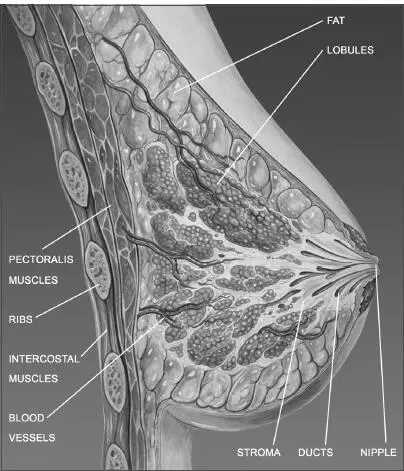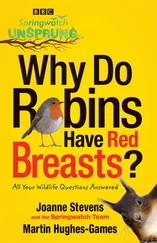BREASTS 101
When it comes to your chest’s general anatomy, breasts remind me of a funky Jell-O fruit salad. Imagine one of your breasts as many bunches of grapes that you’re holding by the top of the largest stems (at the nipple). As you picture these bunches, see all the tiny connecting stems as the tubes that carry milk out of the nipple during lactation (they exist whether you ever get pregnant or not). The stems all connect to grapes, which represent the milk-producing lobules of your breast. The entire breast has fifteen to twenty lobes (grape bunches), and all the stems coalesce toward the nipple, with eight to twelve milk ducts opening on your nipple’s surface.

Patrick J. Lynch, medical illustrator; C. Carl Jaffe, MD, cardiologist. https://commons.wikimedia.org/wiki/File:Breast_anatomy_normal.jpg.
Now, push that entire bunch of grapes and stems, which together comprise what we call glandular tissue, into a mold of Jell-O that’s shaped like your breast and sits on top of your chest wall muscles. (By the way, imagine if Tupperware actually made breast molds. They’d make a killing at “bye-bye breast” parties—or as one of my patients called hers, “Ta-ta, ta-tas!”) The Jell-O represents the supportive structures that surround the breast gland, composed of stroma (a kind of connective tissue), adipose tissue (fat), ligaments, lymphatics, and blood vessels. The lobules and ducts, or grapes and stems, are usually what become cancerous (milk ducts alone are responsible for 75 percent of all breast cancers), but the Jell-O rarely does. For example, a Mayo Clinic review of all breast cancers in women over fifty-nine years old showed that a stromal-based breast cancer, called primary breast sarcoma, accounted for only 0.0006 percent of breast malignancies. 1
Breasts range in size from absent, as seen in a rare disease called Poland Syndrome, to ones that swing down to your knees. Cups go from AAA to L—with the average American cup size being a D; Russia, Sweden, Norway, and Finland have cup sizes larger than D; Australia, France, Italy, the UK, Canada, and South America average a C; in Africa and Asia, women are A/B. Few women have a perfect match. In most, the left breast is up to 20 percent larger than the right (sudden one-sided changes in size are not normal, so if that happens, see your doctor). Your breast size and “perkiness” mostly come from a genetic patchwork of markers handed down from both of your parents to you, plus nutrition and the influence of estrogen, progesterone, insulin, and growth factors during your early years, puberty, pregnancy, lactation, and menopause. Fatness, exercise, aging, skin quality, and hormone use also influence size and shape. Since your breasts contain a genetically predetermined amount of fat, your breasts expand when you do. And contrary to what you may have heard, there’s no direct connection between the size of your breasts and your risk of getting breast cancer.
Your actual breast takes up more space on your body than you probably realize—a point to keep in mind when you do your breast exam every month, as I’ll discuss next. The girls aren’t limited to the two fleshy mounds nestled into your bra. Each breast technically goes all the way up to your collarbone (the clavicle superiorly), centrally to your breastbone (the sternum medially), down to the curve you associate with being the bottom of your breast (the inframammary fold inferiorly), and off to the side of your chest wall (the anterior border of the latissimus dorsi muscle laterally). Another bit of breast tissue extends like the point of a teardrop toward the armpit, called the axillary tail , located just beneath the hair-bearing part of your axilla. Sometimes this tissue actually extends into the armpit itself, which is called axillary accessory breast tissue . When rather pronounced, it bulges out, covered by skin. Depending on whether this happens on one or both sides, you might feel as though you have three or four breasts. An axillary accessory nipple could even connect that breast tissue to your skin, and yes, this means you could actually breastfeed from your triple nipple one day.
All breasts are lumpy, not just cancerous ones. Who in the world ever referred to breasts as melons? Did that person ever feel a breast before? Melons are uniformly firm, round, and very smooth—and they don’t budge when you poke them. The natural terrain of the breast is more like a mountain range with peaks and valleys covered in a blanket of snow (fat) and then wrapped in skin. When you run your fingers across that skin, the snow feels soft until you push deep enough to feel a mountain peak, and with a valley on both sides, that peak sure feels like a lump. The only way to trust that that’s a mountain and not a malignant intruder is to either see a doctor, or to know that it’s been there forever and it’s just your normal anatomy. All breasts have lumps, breasts are lumps, and they feel lumpy. The denser your tissue, the lumpier you feel. Genetics determine breast density, as do the estrogen levels in your body.
Lastly, there’s the surface of the breast. Arteries and veins circulate blood flow to nourish the breast skin, and in lighter-skinned ladies, sometimes we can see the veins rather clearly; also, conditions that increase blood flow will dilate those veins, making them more apparent—especially after exercise, or during pregnancy, or in certain cancers. Nipples can be dark or light, smooth or textured, pointing out, level, or inward, and range in size from flat to a pencil eraser or sugar cubes—it’s all normal. The colored skin around the nipple base is called the areola , and its diameter varies from dimes to saucers, generally 1.5 inches to 4 inches (4–10 centimeters). Some people have additional nipples, called supernumerary nipples, located along two vertical “milk line” arcs from the armpits to the normal nipples to the left and right groin. Occurring in 1 per 8,000 people, these either look like flat moles or have a raised bump. 2Celebs with extra nipples include Mark Wahlberg (three) and Harry Styles (four), so no shame there.
If you zoom in on the areola, there’s so much more to see. All women have hairs that grow at the areolar edge coming from hair follicles. We have fifty million follicles on our skin, so sometimes a few unwelcome strays grow right there. They usually show up in response to hormone changes: puberty, pregnancy, menstruation, menopause, or birth control pills. You can safely tweeze them out or get electrolysis. Tweezing sometimes leads to ingrown hairs, which then cause tiny raised pimples and white sebum to collect. Makes you wonder why you thought tweezing would make the area more attractive. Areolar bumps called Montgomery glands are tiny sebaceous glands whose function is to lubricate the nipple (per textbooks), but since that seems like a fairly useless function and doesn’t even make sense anatomically since they are not on the nipple, I just tell people they are normal and benign and won’t go away no matter how much you squeeze them. You can also get tiny blackheads at the edge of the areola; just wash the area and occasionally exfoliate as you would do to your face at night. If you notice an itchy, scaly, flaky rash on your nipple or areola, call your doctor.
MORE NIPPLE FUN FACTS!
• Some people are born without nipples, which is called athelia . There are about seven thousand diagnosed cases worldwide.
• Nipple stimulation and genital stimulation affect the same part of the brain. One-third of women can reach orgasm solely through having their nips caressed.
Читать дальше













